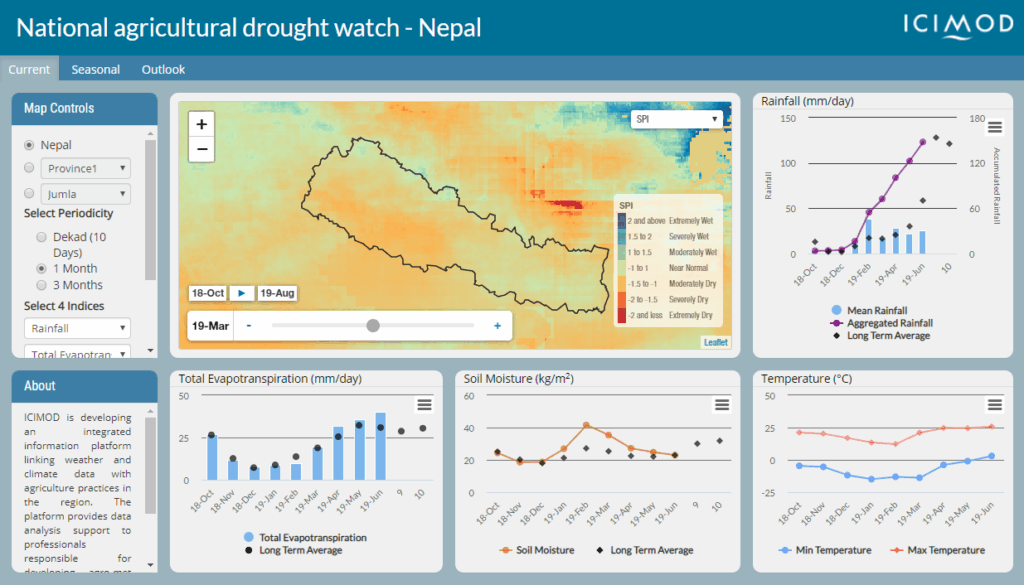Your cart is currently empty!

How Tethys Applications Support Sustainable Farming
—
Agriculture faces an unprecedented convergence of challenges and opportunities. A growing global population demands increased food production while unpredictable weather alters precipitation patterns, temperatures, and growing seasons. Farmers must optimize yields while managing limited water resources, adapting to weather events, and maintaining soil health for long term productivity.
Traditional farming practices, while valuable, may sometimes prove insufficient for navigating these complex, interconnected challenges. The application of data science and technology to farming decisions offers options for addressing these challenges while building more sustainable and resilient agricultural systems.
Expanding on Traditional Knowledge
For generations, farmers have relied on experience, local knowledge, and seasonal patterns to make critical decisions about planting, irrigation, and harvesting. This traditional approach served agriculture well when climate patterns remained relatively stable and resource availability could be predicted based on historical experience.
Today’s agricultural environment demands enhanced approaches. Climate variability makes previous patterns less reliable guides for future conditions. Water resources face increasing pressure from competing uses and changing availability. Input costs fluctuate based on global market conditions that individual farmers cannot control or predict.
Agricultural intelligence supplements traditional knowledge with data-driven insights that help farmers navigate this complexity. Rather than replacing farmer expertise, these tools enhance decision-making by providing information that would be impossible to gather through observation alone.
Integrated Information Systems
The Agricultural Production and Climate Dashboard exemplifies how modern agricultural intelligence integrates diverse information sources to support farming decisions. Developed through collaboration between ICIMOD and national partners in Pakistan, this system provides spatial and temporal information about crops, livestock, agricultural machinery, and climate conditions at the click of a button.
What makes this dashboard particularly valuable is its integration of traditionally separate information sources. Agricultural statistics that might exist only in scattered reports become accessible through interactive maps and visualizations. Climate information from the National Drought Watch connects directly to agricultural production data, helping users understand relationships between environmental conditions and farming outcomes.
This integration proves especially important for policy makers and agricultural planners who need to understand patterns across large regions. The dashboard enables quick analysis for resource planning and decision-making that would be laborious and time consuming using traditional data sources.

Early Warning for Agricultural Risks
Perhaps no application of agricultural intelligence proves more critical than early warning systems for agricultural risks. The National Agricultural Drought Watch systems developed for multiple countries demonstrate how technology can help farmers and agricultural managers prepare for and respond to emerging threats.
These systems provide information on in-season drought conditions and outlook using multiple indices including evapotranspiration, precipitation rate, standardized precipitation index, soil moisture, and temperature. By presenting nine month forecasts for various parameters, the systems enable farmers to make informed decisions about crop selection, planting dates, and resource allocation well in advance of critical growing periods.
The systems also provide baseline information on crop type maps and farming practice calendars valid at the district level. This localized approach ensures that drought information connects directly to the specific crops and practices used in each region, making the warnings more actionable for local farmers.
Data-Driven Resource Management
Agricultural intelligence extends beyond monitoring to active resource management. Modern farming requires careful optimization of inputs including water, fertilizers, and labor. Technology enabled tools help farmers make these optimization decisions based on data rather than assumptions.
Water management exemplifies this optimization potential. By integrating information about soil moisture, crop water requirements, and weather forecasts, farmers can make more precise irrigation decisions. This precision reduces water waste while ensuring crops receive adequate moisture during critical growth periods.
Similarly, information about soil conditions, crop growth stages, and nutrient availability can inform fertilizer application decisions. Rather than applying inputs based on calendar dates or general recommendations, farmers can time applications to match actual crop needs and environmental conditions.
Building Resilient Food Systems
The ultimate goal of agricultural intelligence extends beyond optimizing individual farms to building more resilient food systems that can sustain growing populations while protecting environmental resources. This systemic perspective requires tools that help users understand connections between local decisions and broader outcomes.
Monitoring systems that track agricultural production alongside environmental indicators help reveal these connections. When farmers and policy makers can see how agricultural practices affect water resources, soil health, and ecosystem services, they can make decisions that balance immediate production needs with longer-term sustainability.
Looking Forward
As agricultural challenges continue to evolve, the importance of agricultural intelligence will only grow. New technologies including improved satellite sensors, enhanced climate models, and more sophisticated analytical techniques will create new opportunities for supporting sustainable farming.
However, the success of these technologies will depend on their ability to address real agricultural needs while remaining accessible to the farmers and communities that need them most. The most sophisticated analytical capabilities provide little value if they don’t translate into practical guidance that farmers can implement.
Through platforms like Tethys, the agricultural community can continue developing and sharing tools that transform data into actionable insights for sustainable farming. By connecting scientific understanding with practical management needs, these applications help build agricultural systems that can feed growing populations while protecting the environmental resources on which farming depends.
To learn more about how Tethys applications can support sustainable agriculture in your region, explore our resources and join our community of agricultural scientists, farmers, and technology developers working together to build more resilient food systems.

Leave a Reply